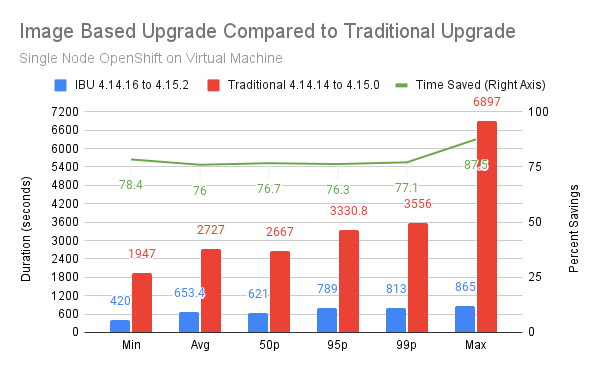Image-based upgrades (IBU) are a developer preview feature in Red Hat OpenShift Container Platform 4.15 that reduce the time required to upgrade a single node OpenShift cluster. The image-based upgrade can perform both Z and Y stream upgrades, include operator upgrades in the image, and rollback to the previous version manually or automatically upon failure. Image-based upgrade can also directly upgrade OpenShift Container Platform 4.y to 4.y+2, whereas a traditional OpenShift upgrade would require two separate upgrades to achieve the same end result (4.Y to 4.Y+1 to 4.Y+2).
An image-based upgrade consists of several stages that the Lifecycle Agent will take a cluster through. Those stages are prep, upgrade, rollback, and idle. The prep stage can be completed outside a maintenance window and downloads the seed image and pre-caches additional images required to perform the upgrade. The upgrade stage performs the upgrade, and rollback can undo an upgrade which returns a cluster back to the previous version. The idle stage is achieved via a finalize policy which brings the cluster back to a state in which a new image-based upgrade can be started and can be initiated after an upgrade or rollback stage completes.
As part of scale and performance testing, we run thousands of upgrades to find bugs, determine success rates, and generally stress test an environment. Scalability and performance testing will find bugs while a system is under immense stress, produce rare bugs such as race conditions, validate a system can complete a function at a specified scale, and determine resource requirements.
Test goal
The main goal of this round of scale testing image-based upgrades is to ensure that Red Hat Advanced Cluster Management for Kubernetes (RHACM) in combination with Topology Aware Lifecycle Manager (TALM) can orchestrate upgrades to 3,500 single node OpenShifts. The time spent per cluster upgrade will then be compared to traditional cluster upgrade data points from similar fleet upgrade tests that have been completed in RHACM Zero Touch Provisioning (ZTP) scale tests.
Test method
To accomplish this, a hybrid testbed that includes a 3-node bare metal OpenShift cluster with RHACM, TALM, and GitOps installed is set up. Another 136 machines serve as hypervisors to host virtual machine single node OpenShifts (SNOs). The hosted VMs are prepared with blank disks such that the Infrastructure Operator which is included with RHACM will install OpenShift via Virtual Media on the target VMs. The Hub cluster then deploys SNOs via a combination of GitOps and ZTP to 3,500 virtual machine single node OpenShifts across the hypervisors.
Once initial deployment is complete, we can then use a PolicyGenTemplate to create RHACM Policies for image-based upgrades. These policies are orchestrated by TALM using a ClusterGroupUpgrade or CGU resource to perform image-based upgrades across the fleet of SNOs. To orchestrate the stages of IBU across 3,500 clusters, the fleet is initially split into 7 groups of 500 clusters. The groups are defined by the clusters selected in each prep CGU spec.clusters array and the additional stages will use labels applied via successful policies in the CGU. This allows the ability to keep failed clusters for analysis and opening bugs. When a cluster completes prep stage, it is labeled such that the associated upgrade CGU will select only the completed prep stage clusters via the CGU spec.clusterSelector.
Each stage will be allowed to run to completion before moving to a new stage, this is to allow time to run diagnostic and data collection scripts to evaluate each stage. This means we will apply 7 CGUs to move all clusters into Prep stage, wait for completion before moving to the upgrade stage. After prep stage completes for all 3,500 clusters, then we begin upgrading the fleet with the upgrade CGUs.
To upgrade the fleet a rate of 1 upgrade CGU applied every 15 minutes was chosen with a 30 minute timeout. This means we expected all clusters in that CGU group to be upgraded or failed to upgrade in 30 minutes after the CGU was applied and enabled. Simply by the definition of the count of clusters (3,500) and the rate 1 CGU every 15 minutes along with the timeout, meant that the maximum amount of time during this entire fleet upgrade would be only 2 hours. Additionally, diagnostic data was collected off of every SNO that completed an upgrade to determine its individual upgrade time.
Test results
After completing several iterations and gathering of IBU duration data, we observed 76 to 87.5% less time spent upgrading each individual cluster when compared across all statistics of 1,000s of upgrade durations. With IBU, while reviewing the 99 percentile of cluster upgrade times, our VM-based clusters completed an upgrade in less than 14 minutes. See Figure 1.

Conclusion
In conclusion, we found that RHACM and TALM can upgrade 3,500 SNOs significantly faster via image based upgrades. IBU becomes even faster if you leverage the ability to skip Y-stream builds to achieve a 4.Y+2 upgrade and the fact you can include Operator upgrades in the image as well. This testing was artificially limited to 500 clusters every 15 minutes as a rate of IBU upgrades, thus we will continue to test larger groups to find the limits of IBU, RHACM, and TALM.
